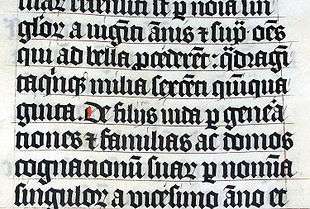Spencerian script
Spencerian Script is a script style that was used in the United States from approximately 1850 to 1925[1] and was considered the American de facto standard writing style for business correspondence prior to the widespread adoption of the typewriter.




Platt Rogers Spencer, whose name the style bears, used various existing scripts as inspiration to develop a unique oval-based penmanship style that could be written very quickly and legibly to aid in matters of business correspondence as well as elegant personal letter-writing.
Spencerian Script was developed in 1840, and began soon after to be taught in the school Spencer established specifically for that purpose. He quickly turned out graduates who left his school to start replicas of it abroad, and Spencerian Script thus began to reach the common schools. Spencer never saw the great success that his penmanship style enjoyed because he died in 1864, but his sons took upon themselves the mission of bringing their late father's dream to fruition.[2]
This they did by distributing Spencer's previously unpublished book, Spencerian Key to Practical Penmanship, in 1866. Spencerian Script became the standard across the United States and remained so until the 1920s when the spreading popularity of the typewriter rendered its use as a prime method of business communication obsolete.
The text in Ford Motor Company's logo is written in Spencerian Script, as is the Coca-Cola logo.[3]
It was gradually replaced in primary schools with the simpler Palmer Method developed by Austin Norman Palmer.
See also
- Copperplate script, a style of calligraphic writing most commonly associated with English Roundhand
- D'Nealian, a style of writing and teaching cursive and manuscript adapted from the Palmer Method
- Palmer Method, a form of penmanship instruction developed in the late 19th century that replaced Spencerian script as the most popular handwriting system in the United States
- Round hand, a style of handwriting and calligraphy originating in England in the 1660s
- Zaner-Bloser, another streamlined form of Spencerian script
- Teaching script
References
- Robinson, Martha (2001). "Developing Spencerian Penmanship at Home: Interview with Michael & Deb Sull". Homeschoolchristian.com. Retrieved 2013-12-11.
- Brian Walker, "Spencerian and Ornamental Penmanship," Pen People Magazine (4 April 2004)
- The Ford Logo That Almost Was, New York Times, 1-21-2010.
